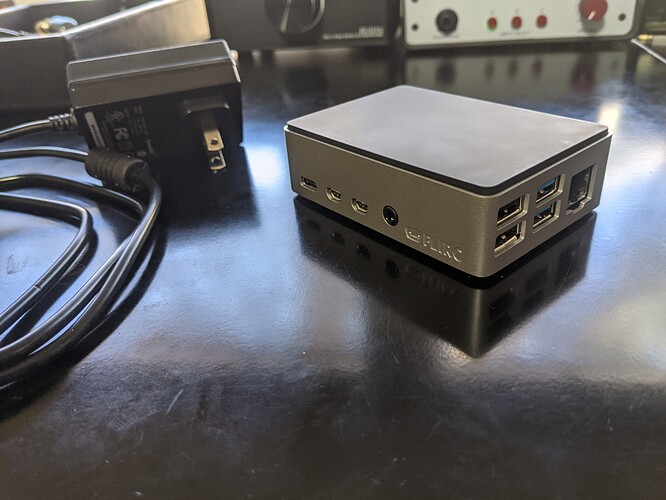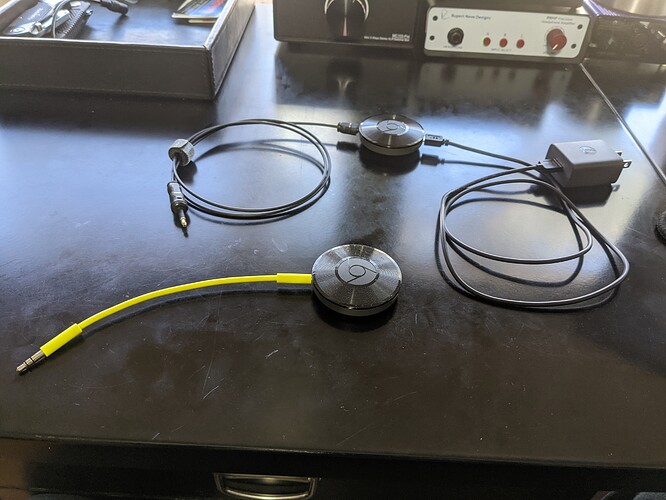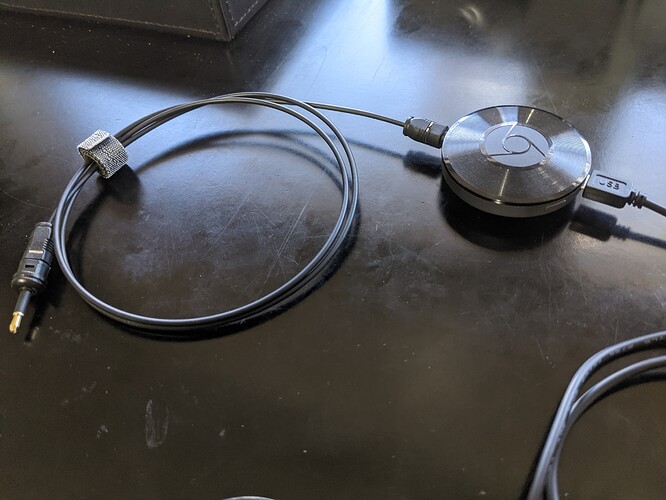TL;DR:
The Raspberry Pi 4 (RP4) is almost as easy to setup and use as a Chromecast Audio (CCA), but the audio performance is far superior. If you have a CCA on hand, try it as a network streamer (via optical output). You’ll be surprised how much you get from such a simple and easy to use setup. If you don’t have a CCA, or want to step up to a higher quality “entry level” streamer, then go for the RP4. You won’t be disappointed!
Setup and background:
My goal here is to make a very basic, entry level comparison of two low cost network streaming options that can be used as Roon endpoints. This may be a fools-errand as many Roon users have the $$$ to buy higher cost dedicated streamers (or DACs with built in streamers). For me, I’ve built my system up with small pieces over the last year. I don’t have $$$ for a high(er) cost streamer. I would rather use that money on a new set of headphones, a new amp, or a new DAC. Spending my limited funds on a high(er) cost streamer never felt right, especially given the option of using a CCA.
I started using Roon (in conjunction with Tidal and/or Qobuz) for two reason:
-
Improve my music discovery – With Tidal and/or Qobuz apps I am able to find music I like, but with Roon I discover new genres and bands on a regular basis, opening up the breadth of my music experience.
-
Support for network streaming – I primarily use laptops and tablets for my day-to-day work. I don’t have a desktop computer in my office to connect my DACs to. Plugging and unplugging the DAC(s) is a pain, and I was concerned that over time the connectors would fatigue. Using a network streamer I can play music from any of my devices without worrying what’s physically connected to my computer.
The network streamer I had on hand (actually, I had five sitting in my closet) was a Chromecast Audio (CCA). So that’s where I started. The Roon implementation for CCA is very good, and I just stuck with that solution for the last year. No complaints!
Recently I posted my “end game” setup here on HiFi Guides, and @Chops called me out for using the CCA. He gave me the push I needed to try a RP4 streaming solution. (Thanks @Chops!) I was hesitant to try an RP4 solution for two reasons (apparently I have two reasons for everything):
- The “DIY” build looked like a time sink
- I thought I needed a high-end audio HAT (ie Pi2AES) to get good sound
But good news, neither of these fears turned out to be true! A simple RP4 build will get up and running in less than 30 minutes. And while upgrading to a Pi2AES HAT (or other audio HAT) is likely an improvement, it’s not necessary to get quality audio. The RP4 USB audio output is a SOLID entry level option. And you can easily upgrade in the future if you like the RP4 solution.
Given that this review / comparison is from the perspective of a Roon user, I am running RoPieee (www.ropieee.org) on the RP4. Most of what I say here will apply to any streaming platform you want to use, but you will need to choose an RP4 installation that supports your service. Volumio (www.volumio.org) is a very popular option that is just as easy to install and setup as RoPieee.
RP4 Build:
The spirit of this post is Keep It Simple Stupid (because usually I fail to do this). Here is the component list @Chops gave me (just order these, don’t over think it):
As of today the total cost of this build from Amazon is $91.75.
I’m running the RoPieee software on the RP4. It covers what you need for Roon endpoint functionality. Go to http://www.ropieee.org/ and follow their setup and installation instructions – the Beginners Guide has everything you need: https://codexwilkes.com/downloads/ropieee-guide-for-beginners.pdf. Very easy instructions to follow. My 9 year old did most of it for me – good project for him to learn on.
CCA Build:
Open the box and plug it in. ![]()
You will need a mini toslink to toslink cable:
This is a cheap (and cheap looking) cable, but I’ve tried many (MANY) cables with my CCA(s), and this one has given the best results. The key build issue with the CCA is the crappy (to use the technical term) mini-toslink connector. It doesn’t properly align the internal source (ie blinky red LED) with the cable. More expensive optical cables don’t help. This cheap one works great – save your money, get the cheap one.
The beauty of the CCA solution is it is plug-and-play. Roon has its own Chromecast implementation that will recognize the device and stream to it. As a benefit, the Roon implementation of Chromecast supports gapless playback.
Selected Feature comparison:
CCA
Roon Endpoint - Yes
Analog Output - 3.5mm
Digital Output - Optical (mini toslink)
Max Data Rate - PCM 24bit / 96kHz
Connectivity - Wi-Fi
Power Supply - 5V, 1A
Unique Features - Chromecast
RP4 (RoPieee)
Roon Endpoint - Yes
Analog Output - 3.5mm
Digital Output - USB (4x)
Max Data Rate - Data rate set by DAC (typically PCM 32bit / 768kHz, DSD512)
Connectivity - Gigabit Ethernet, Wi-Fi
Power Supply - 5V, 3.5A
Unique Features - many, but HQPlayer is a standout for me
Setup and Ease of Use:
The CCA is truly plug and play. Once it is on your wireless network Roon will detect it and allow you to stream through it. Yeehaw!
The RP4 (RoPieee) setup, after you’ve built it, is just as easy. Plug it in and wait ~30 seconds for it to boot. Plug your USB DAC into one of the USB outputs and Roon will detect that DAC. I’ve tried plugging in 4 DACs and once, and it detects all 4 DACs with no issue.
Both are just as easy to stream to via Roon.
Sound Quality:
Now for the part that really counts, sound quality. I Compared the CCA and RP4 with:
- DAC: Soncoz LQ-XD1, JDS Atom DAC, Topping E30, and Schiit Multi-Bit (integrated in Asgard 3)
- Amp: RNHP, Geshelli Erish, and Asgard 3
- Headphones: HD660s, Sundara, and Sony CD900st
My first observation in my testing is that the DAC makes a difference. Their internal implementation of either SPDIF or USB will significantly impact jitter rejection. The Soncoz sounded the best out of this group when listening through CCA SPDIF. The E30 outperformed the Soncoz when listening through RP4 USB. And for the first time I enjoyed the Schiit Multi-Bit DAC card in my A3 – it was a marked improvement over running USB from my laptop. It sounded “musical” – I get why people like the Schiit multi-bit now.
My comparison focused on listening through the Soncoz DAC into the RNHP. I was able to connect the CCA and RP4 to the Soncoz at the same time, enabling easy A/B compare.
On first listen the RP4 was shockingly more clear. So much so I thought something was wrong. After a minute of listening it became clear that what I was hearing was an increase in the dynamic range - the quieter parts of the song are much better separated and distinct from the louder parts. To quote Darko, the instruments on the RP4 sounded more “etched” – separated, distinct, and positioned. Everything just sounded more open and spread out. It was not a subtle difference.
After longer listening sessions I noticed that the music was less fatiguing. I kept wanting more, listening through entire songs instead of skipping to the next song.
This is not to say the CCA was “bad”. It is very listenable – I’ve done so for the last year! But once I compared it to the RP4 it was obviously lower quality. The DAC made up for some of this (Soncoz better than E30), but not so much that it was as good as the RP4.
A good comparison is when I upgraded from the JDS Atom Amp to the RNHP. Both sound good, very enjoyable. But the RP4 has added clarity and depth, the way the RNHP has added clarity and depth over the JDS Atom. If that comparison makes any sense….
Cost and Availability:
The CCA was discontinued by Google in January 2019. They can still be purchased new on the secondary market for $25 - $50. Used you can get them < $20. If you want to try one, PM me, I have a few in my closet looking for a new home.
The RP4 setup is available via Amazon Prime shipping for ~$90. The RoPieee software is Free. There is great community support for the RP4.
Conclusion:
The RP4 running RoPieee is a monster price-to-performance winner. Easily the best $100 I’ve spent in a long time. All of my gear has taken on some new life. The “DIY” nature of it shouldn’t stop anyone from giving this a try. And while I’m sure the USB output isn’t as good as adding an audio HAT (or even a Pi2AES), it’s better than using USB out of my laptop. Keep it simple, start with the RP4 via USB. Enjoy the benefit and flexibility it provides. And then upgrade someday (maybe) to an RP4 with an audio HAT (that’s my plan for some day in the future).
The CCA has its place, especially if you already own one (or five). I’m using one in my garage and one on my back yard patio. For a lower quality sound system you’ll never notice the difference. And they are brilliantly simple and easy to use. True plug-and-play.
Post Script: Never Go Full Retard!
This was me over the last year with my CCAs: https://youtu.be/X6WHBO_Qc-Q
I put a ridiculous amount of time, effort, and money into making my CCAs sound as good as possible – I went full retard. Never go full retard! I supercharged my CCA with:
- UGREEN Ethernet adapter - $12
- iFi iPower 5V Supply - $50
- iFi SPDIF iPurifier2 - $200
First of all, the ethernet adapter made things worse, and cost me a week of debug. Something is wrong with the CCA implementation of wired ethernet and I periodically get dropouts with it. I raised this on the Roon forums and confirmed it with other CCA users. In addition the audio quality was generally degraded, like there was a haze over the music. Don’t go down this path! Just use the CCA wireless, the way god intended it.
Second, the iFi kit did work! The sound is better with it, approaching what the RP4 can do (not quite as good, and still with the 24/96 limitation). For the $250 I spent on the iFi I could build 2 RP4 streamers that have more features and sound just as good. And still have $50 left over (for an audio HAT?).
So, if you experiment with CCA streamers in your system, don’t go full retard! Upgrade to a new streamer first.


